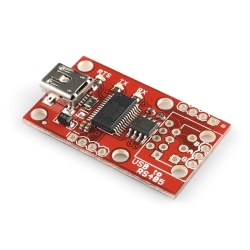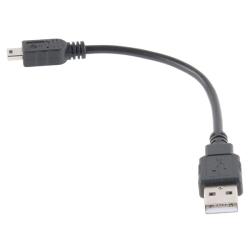SparkFun USB to RS-485 Converter
This breakout board pairs an SP3485 RS-485 transceiver with an FT232RL USB UART IC to convert a USB stream to RS-485.
Product Overview
This is the newest revision of this board and this breakout board pairs an SP3485 RS-485 transceiver with an FT232RL USB UART IC to convert a USB stream to RS-485. The SP3485 is a half-duplex transceiver, so it can only communicate one way at a time, but it can reach transmission speeds of up to 10Mbps.
The TXDEN pin of the FT232RL is connected to the transmit and receive enable inputs of the SP3485, this line is used to control the transmission mode of the RS-485 transceiver. With the proper drivers installed, the FT232RL will enumerate as a virtual COM port; the drivers are available for Windows, Mac and Linux.
This breakout board includes the SP3485, FT232, TX/RX/RTS LEDs, Mini-B USB connector, filter capacitors, and other components shown on the schematic. We've broken out the RS485 output to three different connections: (1) an RJ-45 connector, (2) a 3-pin 3.55mm screw terminal, and (3) a 3-pin 0.1" pitch header; none of these output connectors come populated.
Features & Specs
- Fully equipped with SP3485 RS-485 transceiver and FT232RL USB UART IC
- Operates from USB supply
- RX, TX, and RTS LED indicators
- Mini-B USB connector
- USB power and RX/TX lines broken out to a 0.1" pitch header
- RS-485 input/output broken out to RJ-45 connector, 3.5mm screw terminal, and 0.1" pitch header
- Driver/Receiver Enable connected to RTS line of FT232RL
- -7V to +12V Common-Mode Input Voltage Range
- 1.55x0.9 inches
Documentation
Customer Reviews







